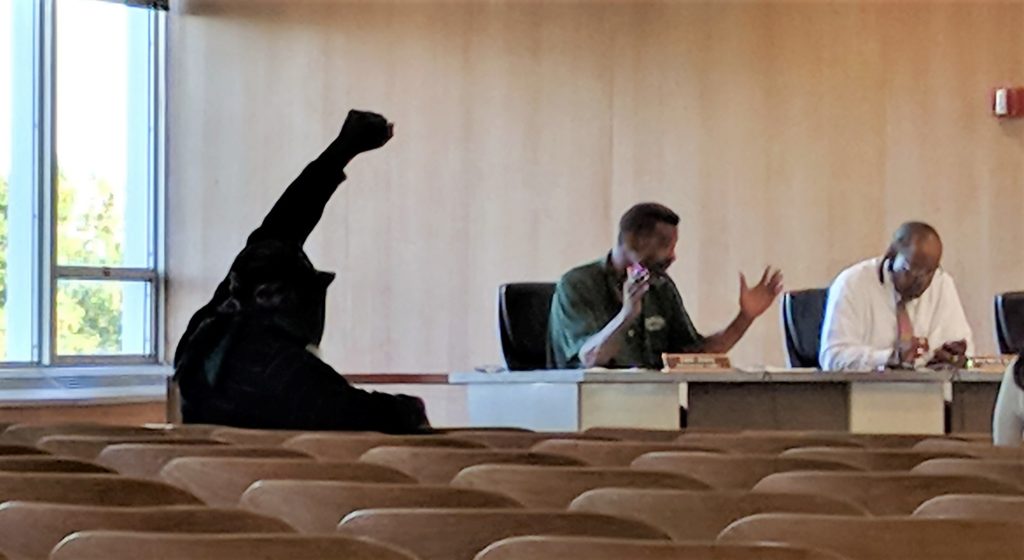By Paul Rozycki
On a recent Monday evening, of the approximately 96,448 residents in the city of Flint, 96,423 were most likely spending their time doing worthwhile, rewarding, or satisfying activities.
The other 25 were at the Flint City Council meeting.
To be sure, some of them had to be there. Nine were elected from their wards as members of the council. Perhaps another half dozen were city employees who were expected to be there. A few reporters attended, also out of a sense of duty, as did some who planned to report on one topic or another. There were a few perennial attendees, who are at every meeting. And there were a few others who had nothing better to do that evening.
That number diminished as the meeting went on, as it usually does, well into the late evening. As the meeting dragged on toward midnight, only a few seats were occupied in the audience, the chamber was nearly empty, and several council members had already left, out of either exhaustion or frustration. One felt sorry for the last person who stayed, to turn out the lights, as the remaining council members shuffled out into the darkness.
With slight variation, that has been the scenario for the Flint City Council meetings for some time. Because earlier committee meetings often ran long, council meetings start late, run well into the night (or early morning), and they seem to accomplish little besides bickering with each other and objecting to each other’s motions.
Covering the council
That presents a problem for those of us who are trying to cover the news and give the public a report on what is taking place in the city government. For the East Village Magazine (EVM), with its small, semi-volunteer staff, getting reporters to attend and cover the Flint City Council meetings has been a challenge. The council obviously plays a major role in shaping and leading the city, and it deserves solid news coverage.

City Council regular R.L. Mitchell supports a point made by First Ward Councilperson Eric Mays, as Second Ward Councilperson Maurice Davis listens (Photo by Paul Rozycki)
EVM is putting together a team to cover the council, with the hope that no one reporter will have to carry the full burden of attending all the numerous and endless meetings. Other news outlets face the same problem. Few reporters can afford to sit through five- or six-hour meetings when they have deadlines to meet and other stories to cover. Thankfully, Paul Herring and his team at Spectacle Productions broadcast and record the meetings on YouTube for those who are not able, or willing, to endure the marathon meetings. For both the media and the public, his recordings are a valuable resource.
Flint’s negative image
But the frustration that EVM faces is only a very small part of the picture. The image of a dysfunctional, divided city reaches far beyond the concerns of one publication. On more than one occasion, a video of Flint’s council, and its members’ outbursts, has gone viral, reminding the nation, one more time, of the many problems we face in the “city with the poisoned water.”
One has to wonder how many prospective businesses look at the Flint City Council and decide that there are other, more welcoming and rewarding places to invest.
How many potential home buyers decide that there might be a better place to live? How many parents decide that other cities are better places to raise their kids, and send them to school? How many future political leaders, who may have real ability, decide that the council is no place to begin a successful career in government, and look elsewhere? How many foundations avoid working with the council while they develop their plans and goals for Flint’s future?
As if the Flint water crisis weren’t enough to tarnish the city’s reputation, one recent source listed Flint as one of the worst governed cities, in a recent survey of major cities in the U.S. The council isn’t totally to blame for that dubious distinction, but it sure doesn’t help.
Somehow, things do get done … sometimes
Yet, in the midst of all the turmoil and endless meetings, things do get done — budgets are approved, appointments are made, and routine business is taken care of. Given the major problems that Flint faces, that’s no small accomplishment. The frequent chaos and conflict in the council make it easy to forget that many on the council go well beyond the call of duty to respond to constituents, and learn the intricacies of budgets, contracts, grants, and personnel policies. It’s doubtful that many other city councils put in as much time, or face as much personal frustration as Flint’s does.
But much of that frustration is self-inflicted. In the midst of a mayoral campaign, members of the council are still trying to recall other councilmembers; the hiring of an ombudsperson, as required by the new charter, is still incomplete; and a dispute over who should get a contract to clean up the lawns and sidewalks drags on as agreements change and residents wait.
While there have been some meetings where the members of the council showed an ability to work toward a common goal, all too often that is the exception. Few meetings take place without personal attacks and conflict between council members.
The situation with the Flint City Council didn’t happen in a vacuum. Flint has a long history of divisive politics. We have a history of bitter conflict between management and labor, racial division, and city versus suburban friction. The council may simply mirror those divisions and conflicts.
It’s not just Flint
And while the council may be a prime example of those divisions and problems, they aren’t unique. While not as dramatic, similar frictions and clashes have marked the Flint School Board, the Genesee County Commission, and other local governments.
It’s also no surprise that we live in divisive times. Our last governor spent as much time fighting with his own party as much as he did with the opposing Democrats. Our current governor is trying to bridge a deep division between the Democratic governor’s office and the Republican legislature. And in Washington, the clash between the Trump White House, the Democratic House of Representatives, and other parts of the government grows more intense by the day, and only fuels the divisions in the nation.
Unfortunately, Flint’s City Council may be both a reflection of our times, and our own local history.

Paul Rozycki (Photo by Nancy Rozycki)
One of the harshest critiques of democracy is that sometimes you get the government you deserve. In the final analysis it’s up to us, the voters, to not only elect those who are competent, but those who are willing, and able, to work with others and abide by the common behavior of a civil society.
If we do, maybe more than just a tiny handful of us (.00026 percent) will be willing to show up at Flint City Council meetings.
Maybe, just maybe, that might make a difference.
EVM Staff Writer and political commentator Paul Rozycki can be reached at paul.rozycki@mcc.edu.


You must be logged in to post a comment.